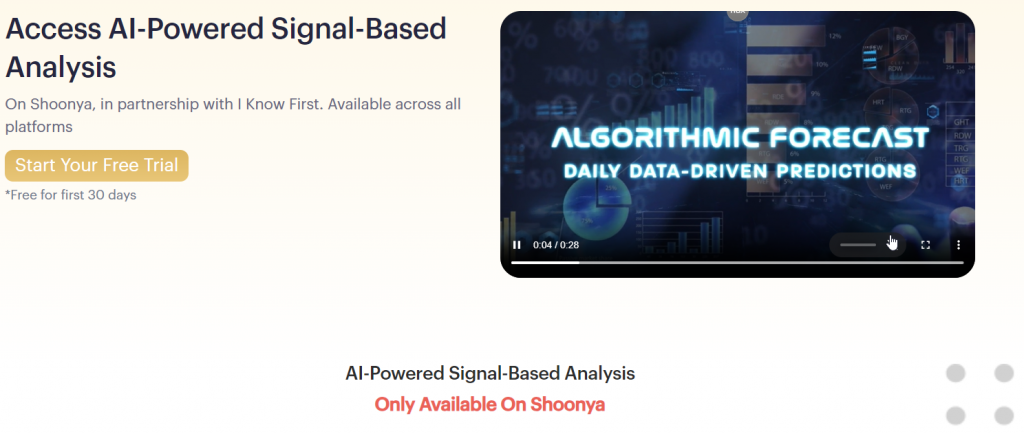20 Good Facts For Deciding On copyright Ai Trading Bot Websites
20 Good Facts For Deciding On copyright Ai Trading Bot Websites
Blog Article
Top 10 Things To Consider When Evaluating The Security And Privacy Of Ai-Based Stock Prediction And Analysis Platforms
If you are using trading platforms that use AI to predict and analyze the price of stock privacy and security are key. These platforms often handle sensitive financial and personal data. An attack on data or misuse can result in significant financial losses as well as reputational damage. Here are the top 10 ways to evaluate the security and privacy on these platforms.
1. Check the Data Encryption
Security on the move: Ensure that the service you are using uses secure protocols to encrypt your data as it travels between their servers and the device (e.g. TLS/SSL).
Secure data encryption at rest: Ensure the encryption of sensitive data on the platform's server using strong encryption standard (e.g. AES-256).
Check for end-toend security: This is a must in order to secure sensitive data or communications.
2. Review the Authentication Methods
Two-factor authentication (copyright) You must ensure that your platform supports this to add an extra layer of security.
Biometric authentication - Check for biometric options for mobile app login (e.g. finger print, facial recognition).
Password policies. Check if the platform enforces password policies that are strong (e.g. minimum length or the requirement for complexity).
3. Check for Compliance
Financial Regulations: Make sure that the platform is compliant with relevant financial regulations.
Laws on data protection: Check for compliance with data privacy laws (e.g. GDPR, GDPR, CCPA) if you are operating in or trading with areas covered by these laws.
Audit certifications. Check that the platform you are considering has passed third-party tests of security or has been certified.
Review Controls for Access to Data
Role-based access: Make sure the platform uses role-based access controls (RBAC) to restrict data access to authorized users.
Permission levels - Verify that you are able to assign different permissions to users or members.
Activity monitoring: Find out if the platform monitors and records user activity for suspicious behavior.
5. Evaluate Vulnerability Management
Updates on a regular basis: The platform needs to regularly update its software to fix weaknesses.
Penetration test: See if your platform is regularly tested to detect and fix any security vulnerabilities.
Bug bounty programs: Check if there is a bug-bounty program that is available to motivate security researchers from other sources to report weaknesses.
6. Evaluate Data Privacy Policies
Transparency Privacy Policies: Read the privacy policies of the platform to find out the ways in which your information will be used, collected and shared.
Data minimization - Ensure that the platform collects only the information that it needs to operate.
Third-party sharing : Review the policies of the platform for sharing data and conditions.
7. Secure API usage is monitored
API security: Make sure the API of the platform API utilizes secure authentication methods (e.g., OAuth, API keys) and secures data exchanges.
Limiting rate. Examine the API's rate limiter to avoid abuse.
Check the logs of access. Check that the platform tracks API use and logs it for monitoring.
8. Evaluate the recovery of an incident and respond
Incident response plan: Ensure that your platform is equipped with an incident response plan for handling security breaches or data breaches.
Notification policies: Determine if users are informed promptly in case of a security breach.
Data backups: Check if the platform regularly backs up the data it stores and has a disaster recovery plan in place.
9. Evaluation of Physical Security Measures
Security of the data center Security of servers: Ensure that the servers of your platform are situated in data centers that are equipped with physical security measures including access control and surveillance.
Redundancy - Make sure that the platform is equipped with redundant systems to ensure data availability in the event that hardware fails.
Geographic distribution: Make sure that data is distributed across multiple geographical locations to increase the resilience.
10. Test User Privacy Controls
Data deletion: Ensure that the platform permits you to erase your personal information permanently when you cease making use of the platform.
Privacy settings: Determine whether your platform provides privacy settings for controlling what data can be disclosed or made public.
Check for anonymization. This is crucial when you use the platform for analysis or machine-learning.
Bonus Tips
User reviews and feedback Review and feedback from users to assess the reputation of a platform in terms of security and privacy.
Trial period for free: Experience the privacy and security features with an online demonstration.
Customer support: Ensure the platform provides a solid support regarding security issues or concerns.
Following these tips can help you assess the security and privacy features of AI software for predicting or analyzing trades. It will help ensure that your financial and personal information is secure. Secure platforms not just protect your assets, but also increase confidence and trust in the services. Follow the best what do you think for blog examples including best stock advisor, ai stock prediction, copyright ai trading bot, ai investment advisor, trading ai, best ai stock trading bot free, ai trader, trader ai app, ai trading tools, ai stock picker and more.
Top 10 Tips To Assess The Risk Management Of Ai Stock Predicting/Analysing Trading Platforms
Risk management plays a crucial role in any AI-based platform for trading stocks. It protects your capital by limiting losses that could occur and assists you in maximizing profits. Platforms with robust risk management features will help you navigate the market volatility and make an informed decision. Here are 10 guidelines for evaluating the platform's risk management capabilities.
1. Examine Stop-Loss and Take Profit Features
Level that you can customize: You should be able to customize the levels of take-profit and stop-loss for individual trades and strategies.
Check whether the platform allows the use of trails stops. They will automatically adapt themselves when markets move in your favor.
Guaranteed stop orders: Find out whether the platform provides guarantees on stop-loss orders that assure that your trade is completed at the exact price regardless of market volatility.
2. Measure Positions Tools
Fixed amount. Make sure you have the option to define the size of your positions in terms of the fixed dollar amount.
Percentage of portfolio: Check whether you are able to set size limits as a percentage of your portfolio total to control risk in a proportional manner.
Risk-reward: Make sure your platform lets you set risk-reward for each strategy or trade.
3. Make sure you have Diversification Support
Multi-assets trade: Ensure that the platform can support trading across multiple asset categories (e.g. ETFs, stocks options, forex and more.) to diversify portfolios.
Sector allocation: Determine if your platform has tools for monitoring and managing the exposure to sectors.
Geographic diversification. Examine the platform you use allows the trading of international markets. This will aid in spreading the risk across different geographic areas.
4. Evaluating margin and leverage controls
Margin requirements: Make sure the platform clearly outlines the margin requirements for leveraged trading.
Leverage limits: Check whether the platform permits you to set limits on leverage to control risk exposure.
Margin call notifications: Make sure that the platform provides timely margin call notifications to stop account liquidation.
5. Assessment and reporting of risk
Risk metrics: Make sure the platform provides key risk metrics (e.g., Value at Risk (VaR) Sharpe ratio drawdown) for your portfolio.
Scenario Analysis: Check whether your platform has the capability of generating different market scenarios to assess possible risks.
Performance reports - Verify that the platform provides specific performance reports, including return adjustments for risk.
6. Check for Real-Time Risk Monitoring
Portfolio monitoring - Make sure that the platform you select offers real-time monitoring to ensure your portfolio is secure.
Alerts and notifications. Verify whether the platform can provide real-time notification of risk-related events.
Risk dashboards: Find out whether the platform has customizable risk dashboards for an in-depth view of your risk profile.
7. How can you assess the results of Stress Testing and Backtesting
Stress testing: Make sure the platform allows you to stress test your portfolio or strategies under the most extreme market conditions.
Backtesting - Check to see whether your platform permits you to test strategies back using old data. This is a great way to measure risk and assess performance.
Monte Carlo simulators: Verify that the platform uses Monte Carlo to simulate a range of outcomes that could occur so that you can evaluate risk.
8. Risk Management Regulations: Assess compliance
Compliance with regulatory requirements: Ensure that the platform complies with applicable risk-management regulations (e.g. MiFID II, Reg T, in the U.S.).
Best execution : Check to find out if your platform uses the most efficient execution methods. This guarantees that trades will be executed for the best possible price, minimizing the chance of slippage.
Transparency: Make sure that the platform provides transparency and clear disclosures of the risks.
9. Examine the User-Controlled Risk Parameters
Custom risk rules - Make sure that the platform allows you to create your own risk management guidelines.
Automated risks controls: Verify whether the platform can automatically enforce rules for risk management based on your defined parameters.
Manual overrides: Make sure that the platform supports manual overrides during emergency situations.
10. Review User Feedback and Case Studies
User reviews: Study user feedback and assess the platform’s efficiency in the management of risk.
Case studies Find cases studies or testimonials, that prove the platform's ability to manage risks.
Community forums - Search for yourself if the platform offers a user community that is active, and where traders are able to share their strategies for managing risk.
Bonus Tips
Trial period: Take advantage of a free demo or trial period to try the platform’s risk management capabilities in real-world scenarios.
Customer support - Ensure that the platform has robust support for questions and issues concerning risk.
Educational resources: Discover whether your platform has tutorials or educational materials that provide information on risk management techniques.
Use these guidelines to evaluate the risk management capabilities of AI trading platforms which predict and analyze the prices of stocks. Choose a platform that offers an excellent quality of risk-management and you'll be able to minimize your losses. To navigate turbulent markets and attain long-term gains in trading you require a reliable risk management software. Follow the top rated funny post for website advice including ai stocks to invest in, stock analysis app, copyright financial advisor, stock ai, ai stocks, investing ai, ai stock market, trading chart ai, ai hedge fund outperforms market, getstocks ai and more.